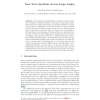Free Online Productivity Tools
i2Speak
i2Symbol
i2OCR
iTex2Img
iWeb2Print
iWeb2Shot
i2Type
iPdf2Split
iPdf2Merge
i2Bopomofo
i2Arabic
i2Style
i2Image
i2PDF
iLatex2Rtf
Sci2ools
AMFG
2005
IEEE
2005
IEEE
Face View Synthesis Across Large Angles
Pose variations, especially large out-of-plane rotations, make face recognition a difficult problem. In this paper, we propose an algorithm that uses a single input image to accurately synthesize an image of the person in a different pose. We represent the two poses by stacking their information (pixels or feature locations) in a combined feature space. A given test vector will consist of a known part corresponding to the input image and a missing part corresponding to the synthesized image. We then solve for the missing part by maximizing the test vector’s probability. This approach combines the “distance-from-feature-space” and “distance-in-feature-space”, and maximizes the test vector’s probability by minimizing a weighted sum of these two distances. Our approach does not require either 3D training data or a 3D model, and does not require correspondence between different poses. The algorithm is computationally efficient, and only takes 4 - 5 seconds to generate a face....
Related Content
| Added | 24 Jun 2010 |
| Updated | 24 Jun 2010 |
| Type | Conference |
| Year | 2005 |
| Where | AMFG |
| Authors | Jiang Ni, Henry Schneiderman |
Comments (0)

